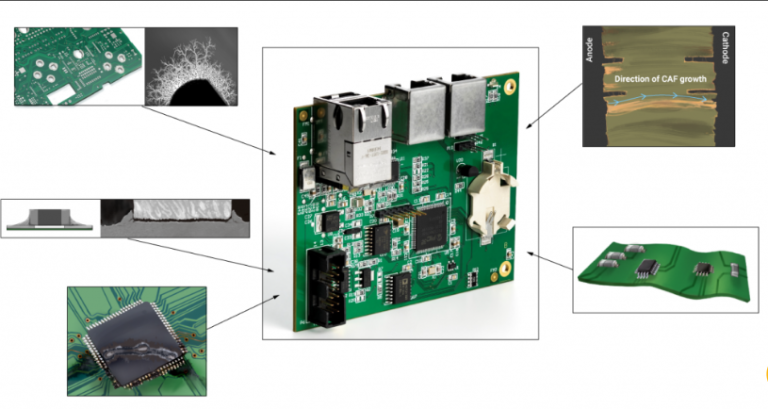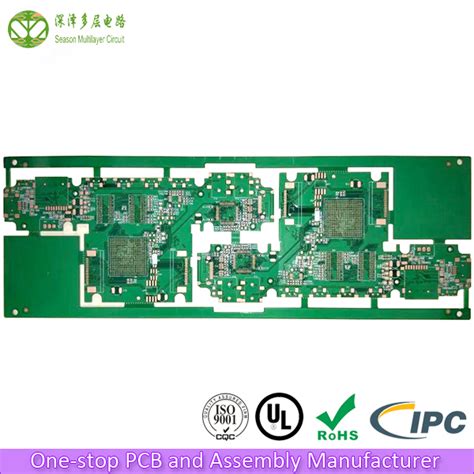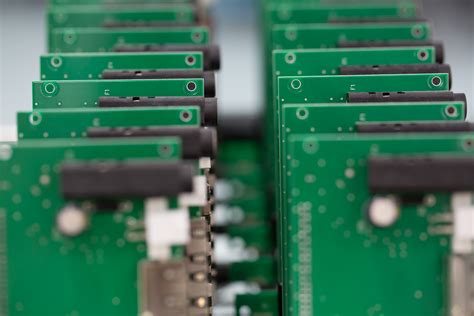Mastering 6 Layer PCB Fabrication: A Comprehensive Guide
Key Takeaways
Mastering 6 layer PCB fabrication is crucial for anyone involved in the PCB manufacturing industry. By understanding the fundamentals, you can navigate through various aspects such as stack-ups and different manufacturing processes effectively. This knowledge aids in identifying how the structure of your PCB influences its overall functionality and performance. As you explore different etching methods, it becomes clear that choosing the right technique can significantly impact both the quality and cost-effectiveness of your products. Keep in mind that if you collaborate with reputable PCB manufacturing companies, you may find innovative solutions to streamline your designs while reducing PCB manufacturing costs. In addition to this, being aware of common challenges encountered during production helps you mitigate risks and enhances your confidence in running a successful PCB manufacturing business. Ultimately, focusing on these key areas will foster efficiency and drive optimal performance in your 6 layer PCB designs.
Understanding 6 Layer PCB Stack-Ups
When it comes to 6 layer PCB fabrication, understanding the concept of stack-ups is fundamental to the process. A stack-up refers to the arrangement of copper layers and insulation layers in a printed circuit board (PCB). For a 6 layer PCB, it typically consists of alternating layers, with each layer serving a specific purpose, such as signal routing, power distribution, and ground connections.
The most common configuration includes two outer layers for signal routing, two inner layers for power and ground, and two additional layers that manage signal integrity. Properly designing your stack-up can significantly impact the overall performance of your circuitry. Keeping in mind the pcb manufacturing cost, balancing layer designs effectively while ensuring functional reliability is crucial for successful outcomes.
Here is a sample table illustrating a typical 6 layer PCB stack-up configuration:
| Layer Number | Layer Type | Primary Function |
|---|---|---|
| 1 | Signal | Top signal routing |
| 2 | Ground | Ground plane |
| 3 | Power | Power distribution |
| 4 | Signal | Inner signal routing |
| 5 | Ground | Internal ground plane |
| 6 | Signal | Bottom signal routing |
“When selecting a stacking arrangement, consider factors such as impedance control, thermal management, and electrical performance,” suggests industry experts.
Furthermore, being aware of how various pcb manufacturing companies approach stack-ups can provide you with insights into best practices and trends in design. Each choice you make during this stage contributes to the success of your pcb manufacturing business by ensuring efficient circuitry that resonates with high performance while keeping in mind potential impacts on costs.
In summary, investing time in understanding the intricacies of your PCB stack-up will not only enhance performance but may also streamline your project timelines and reduce overall costs associated with pcb manufacturing. For more detailed information on this topic and professional assistance with fabrication needs, you might find visiting Andwin helpful.
Key Manufacturing Processes in 6 Layer PCB Fabrication
In 6 layer PCB fabrication, several key manufacturing processes come into play to ensure the final product meets the desired specifications and performance standards. The process typically begins with the careful selection of materials, as the right substrate is crucial for overall functionality and durability. Once materials are chosen, pcb manufacturing companies often utilize advanced techniques for layer stacking, ensuring that each layer is aligned precisely. This alignment is vital for minimizing signal interference and enhancing the reliability of your circuits.
Next, you will encounter etching methods, which are essential in defining the circuitry patterns on each layer. Different methods, such as photo-sensitive etching or chemical etching, can be employed depending on your requirements and budget. This aspect ties closely with pcb manufacturing costs, as certain techniques may prove to be more economically viable than others while still achieving high-quality outcomes.
Once the layers are appropriately etched, a process called lamination takes place, which fuses all layers together under heat and pressure. This step demands attention to detail; any misalignment can compromise the integrity of your circuit design. Furthermore, establishing connections between layers usually involves intricate drilling processes that create vias—essential conduits in multilayer circuit boards.
By understanding these critical processes in pcb manufacturing, you can identify avenues for improvement and cost savings in your own pcb manufacturing business. Whether you’re a seasoned designer or new to circuit board fabrication, grasping these fundamentals will empower you to enhance both efficiency and performance in your electronic designs.
Exploring Etching Methods for 6 Layer PCBs
When it comes to 6 layer PCB fabrication, one of the most critical processes you will encounter is etching. This method is essential for defining the intricate patterns that will direct electrical signals across your circuit board. The etching process typically involves using chemical solutions to remove unwanted copper from a clad board that has previously been coated with a photoresist material. Understanding this technique is vital for anyone in the PCB manufacturing business or those collaborating with PCB manufacturing companies.
There are primarily two types of etching methods you should be aware of: subtractive etching and laser etching. Subtractive etching is the most widely used technique in traditional manufacturing settings, allowing you to achieve complex geometries with relative ease. By employing specific chemicals, you can ensure the precise removal of copper, which helps in maintaining high circuit integrity. On the other hand, laser etching represents a more modern approach, offering greater versatility and speed. It’s particularly favored for prototypes or smaller production runs due to its ability to rapidly adjust designs without altering masks.
Being knowledgeable about these etching processes not only enhances your understanding of how PCBs are manufactured but also enables you to evaluate the PCB manufacturing cost associated with different approaches. For instance, while laser etching might entail higher upfront costs due to equipment investments, it could save money in labor and time during production runs. This knowledge becomes crucial when deciding which services from various PCB manufacturing companies align best with your project’s specific requirements.
Ultimately, being familiar with different etching methods empowers you to optimize your designs for both efficiency and performance while keeping an eye on costs throughout the lifecycle of your 6 layer PCBs.
Design Considerations for Efficient 6 Layer PCBs
When embarking on 6 layer PCB fabrication, it’s essential to consider various design factors that influence not only the functionality but also the pcb manufacturing cost. One of the primary aspects to focus on is the stack-up configuration. Properly arranging your layers can help in minimizing signal interference and optimizing thermal management, which are crucial for high-performance applications. Additionally, you’ll want to pay attention to trace width and spacing; these details can significantly impact both the performance of your circuit and the overall manufacturability.
Collaboration with pcb manufacturing companies during the design phase can provide valuable insights into how your layout choices affect production. Engaging with professionals in this field often leads to innovations in design that enhance efficiency while managing costs effectively. Remember to account for material specifications and layer thicknesses, as these can alter pcb manufacturing business dynamics, particularly regarding lead times and overall product quality.
Lastly, don’t overlook the importance of robust design rules in software tools used for PCB layout. Ensuring compliance with best practices not only streamlines the production process but also reduces potential pitfalls that could escalate manufacturing costs or delay timelines. By addressing these considerations upfront, you will set a solid foundation for successful 6 layer PCB fabrication that balances both performance requirements and economic feasibility.
Common Challenges in 6 Layer PCB Production
In the realm of 6 layer PCB production, several challenges can arise that may affect the overall quality and cost of your project. One significant issue is achieving the right stack-up configuration. The arrangement of layers is critical, as improper layering can lead to issues such as signal interference and uneven thermal management. Additionally, you’ll need to interact with numerous PCB manufacturing companies to ensure that they understand your specific design needs; miscommunication can result in costly revisions. The pcb manufacturing cost also often escalates due to unexpected complexities during the fabrication process, such as difficulties in achieving precise etching. Furthermore, you might encounter challenges related to tight tolerances and intricate designs that are standard for multilayer boards. Maintaining compliance with industry standards while keeping a keen eye on production timelines is essential for your pcb manufacturing business to thrive amidst these obstacles. By staying informed and adapting your designs accordingly, you can mitigate these common issues effectively, leading to successful outcomes for your PCBs.
Optimizing Performance in 6 Layer Circuit Designs
When you embark on the journey of 6 layer PCB fabrication, optimizing the performance of your circuit designs is paramount. This begins with understanding the pcb manufacturing processes that influence your design’s functionality. Effective layer stack-ups play a crucial role; ensuring that power and ground planes are positioned correctly can significantly reduce noise and improve signal integrity. Furthermore, engaging with reputable pcb manufacturing companies can assist you in selecting materials and component placements that enhance thermal management, allowing your circuitry to operate efficiently.
You should also consider the pcb manufacturing cost as it impacts the overall performance-to-cost ratio of your design. Balancing features and functionality with budget constraints is essential. For instance, if you are considering high-speed applications, investing in high-quality materials might raise your initial costs but will yield superior long-term performance.
In this competitive pcb manufacturing business, staying updated with the latest technologies in etching methods and fabrication processes is critical for achieving optimal performance. By leveraging advanced techniques such as laser-cutting or photolithography, you can produce finer traces that cater to high-frequency applications or intricate layouts, ultimately translating to a more robust final product. The careful integration of these strategies will allow your 6 layer circuits to perform at their best while meeting cost-effectiveness criteria. Thus, striking an ideal balance between performance optimization and manufacturing efficiency is key to success in this field.
Best Practices for Cost-Effective 6 Layer PCB Manufacturing
When engaging with pcb manufacturing, cost-effectiveness is a priority that can significantly influence your project’s success. To achieve this, you should first focus on selecting the right pcb manufacturing companies that provide competitive pricing without compromising on quality. Compare quotes and services, paying attention to their previous work and customer feedback to determine their reliability. Another essential practice is to consolidate your designs; minimizing the complexity of your layouts can reduce the overall pcb manufacturing cost. You might also consider using automated processes in production, which not only speeds up fabrication but also decreases labor costs. Additionally, leveraging advanced software tools enables precise design and reduces errors, which can lead to costly delays—something you definitely want to avoid in your pcb manufacturing business. Finally, maintaining a strong communication channel with your manufacturer could ensure that any design modifications or issues are dealt with promptly, minimizing waste and aligning your project timelines with cost expectations. Implementing these best practices will set a solid foundation for affordable and efficient 6 layer PCB production.
Conclusion
In summary, mastering 6 layer PCB fabrication is essential for enhancing the efficiency and performance of your electronic devices. As you venture into the realm of pcb manufacturing, it’s crucial to consider various factors such as stack-ups, manufacturing processes, and design considerations. Understanding these elements allows you to optimize your designs and mitigate common challenges faced in production. When dealing with pcb manufacturing companies, always aim for those that offer a balance of quality and cost-effectiveness, as this can significantly influence your overall pcb manufacturing cost. Engaging in a well-planned pcb manufacturing business not only ensures the production of reliable circuit boards but also fosters sustainable practices that are beneficial in the long run. By applying the knowledge gathered from this guide, you can make informed decisions that enhance your circuit designs while keeping an eye on performance and budget constraints. Be proactive in researching potential suppliers and understanding how each step in the fabrication process impacts the final product to achieve optimal results in your projects.
FAQs
What is involved in the pcb manufacturing process for 6 layer PCBs?
The pcb manufacturing process involves several stages, including design, etching, layering, and final assembly. Each stage is crucial for ensuring that your PCB meets the required specifications and performance standards.
How do I estimate the pcb manufacturing cost for a 6 layer PCB?
To estimate the pcb manufacturing cost, consider factors such as material selection, complexity of the design, and production volume. Typically, higher layer counts and more intricate designs will lead to increased costs.
What should I look for in a reliable pcb manufacturing company?
When selecting a pcb manufacturing company, prioritize their experience in producing multilayer boards, their quality certifications, customer reviews, and turnaround times. It’s essential to choose a company that can meet your specific project requirements.
Are there specific challenges associated with 6 layer PCB production?
Yes, challenges may include alignment issues during layering, potential signal integrity problems due to increased complexity, and ensuring efficient heat dissipation across multiple layers. Understanding these challenges can help you optimize your design.
How can I optimize my design for efficient pcb manufacturing?
To optimize your design for efficient pcb manufacturing, keep components evenly distributed across layers to minimize complex routing. Consider using blind or buried vias to enhance space utilization while also making sure your layout adheres to the manufacturer’s guidelines.







